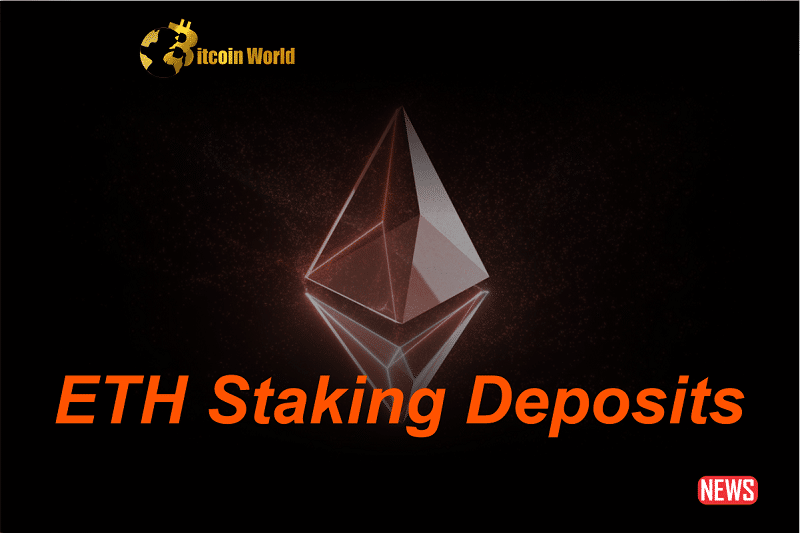The Ethereum network is buzzing with activity! If you’re keeping an eye on the crypto space, particularly Ethereum, recent trends are painting a fascinating picture of its health and future direction. Let’s dive into what’s been happening and what it means for you.
Is Ethereum Becoming More Enticing to Stake?
Absolutely! We’ve seen a significant shift in the staking landscape. Imagine this: in the last 24 hours, a whopping 192,000 ETH flowed into staking contracts, while only 29,000 ETH was withdrawn. That’s a substantial net positive, indicating strong confidence in staking Ethereum.
Why is this noteworthy? Well, since the Shapella upgrade in April, which unlocked the ability to withdraw staked ETH, this is the first time we’ve seen sustained deposits outpace withdrawals. This suggests a growing belief in the long-term prospects of staking and the rewards it offers. It’s a powerful signal that investors are locking up their ETH, potentially reducing selling pressure and contributing to network stability.
The Burning Question: Why is So Much ETH Being Burned?
Another key trend is the increasing amount of ETH being burned. Over the past week alone, more than 61,000 ETH has been taken out of circulation. This ‘burning’ mechanism is part of Ethereum’s EIP-1559 upgrade, which ties the burning of ETH to network activity. The more transactions happening, the more ETH gets burned, potentially making the asset more scarce over time.
So, who’s responsible for this fiery activity? Look no further than Uniswap, the leading decentralized exchange. Remarkably, Uniswap accounts for nearly half of all the ETH burned recently. This highlights the sheer volume of trading activity happening on this platform. It’s a testament to the popularity and utility of decentralized exchanges within the Ethereum ecosystem.
Let’s break down the impact:
- Reduced Supply: Burning ETH effectively reduces the total supply, which, according to basic economics, can potentially increase its value over time.
- Network Health Indicator: High burn rates often correlate with high network activity, signifying a healthy and active Ethereum ecosystem.
- Uniswap’s Dominance: The significant contribution of Uniswap underscores its central role in decentralized finance (DeFi) and the Ethereum network.
What’s Next for Ethereum? Enter Dencun and EIP-4844
The Ethereum Foundation isn’t resting on its laurels. They’re already looking ahead to the next major upgrade, codenamed Dencun. Key decisions have been made regarding which Ethereum Improvement Proposals (EIPs) will be included, and one stands out in particular: EIP-4844, also known as ‘The Surge’.
Why should you be excited about EIP-4844? It’s all about making Ethereum more scalable and affordable. This upgrade is specifically designed to drastically reduce transaction fees on Layer-2 networks. Think of Layer-2 networks like express lanes on a highway – they process transactions off the main Ethereum chain, making things faster and cheaper.
Here’s a simplified view of the benefits of EIP-4844:
| Feature | Benefit |
|---|---|
| Reduced Layer-2 Fees | Makes using applications built on Layer-2 networks significantly cheaper. |
| Increased Scalability | Allows Layer-2 networks to handle more transactions, improving overall network capacity. |
| Enhanced User Experience | Lower fees and faster transactions lead to a smoother and more accessible experience for users. |
EIP-4844 is a crucial step towards making Ethereum more accessible for everyday users and developers, paving the way for wider adoption of decentralized applications.
Validating Everything: The Power of Ethereum Attestation Service (EAS)
Beyond upgrades and burning mechanisms, there’s another interesting development worth noting: the Ethereum Attestation Service (EAS). This often-overlooked project has recently been updated to allow users to validate any type of file. Launched on both the Ethereum mainnet and Arbitrum in March, EAS is designed as a public good.
What does EAS do? It provides a valuable tool for verifying the authenticity and quality of data. Imagine being able to definitively prove the origin or integrity of a document, a piece of code, or any digital asset. That’s the power of EAS. Crucially, it’s designed to be a public benefit and doesn’t rely on tokens, making it accessible to everyone.
Think of it as a digital notary service, but on a decentralized and transparent blockchain. This can have significant implications for various industries, from supply chain management to verifying credentials and combating misinformation.
Key Takeaways and What It Means for You
- Increased Staking Confidence: The surge in ETH staking post-Shapella signals strong belief in Ethereum’s future and the rewards of staking.
- Burning Dynamics: High network activity, particularly on Uniswap, is driving significant ETH burns, potentially impacting its long-term value.
- Dencun’s Promise: The upcoming Dencun upgrade, with EIP-4844 at its core, aims to make Ethereum more scalable and affordable, particularly for Layer-2 users.
- EAS for Verification: The Ethereum Attestation Service offers a valuable public good for data validation and integrity.
The Ethereum ecosystem is constantly evolving, with exciting developments happening on multiple fronts. From increased staking and burning to significant upgrades and public goods, the network is demonstrating its resilience and its commitment to innovation. Staying informed about these trends is crucial for anyone involved in the cryptocurrency space, whether you’re an investor, developer, or simply a curious observer.
Disclaimer: The information provided is not trading advice, Bitcoinworld.co.in holds no liability for any investments made based on the information provided on this page. We strongly recommend independent research and/or consultation with a qualified professional before making any investment decisions.


